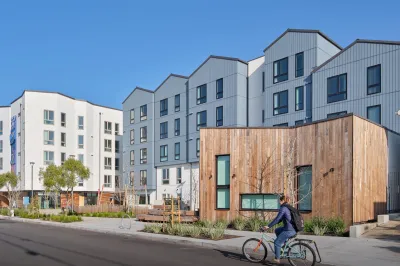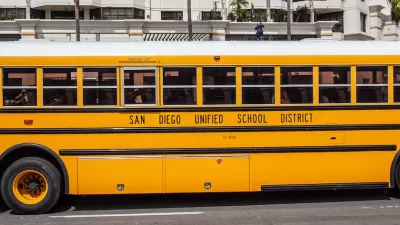SFUSD joins a growing list of school districts using their land holdings to address housing affordability challenges faced by their own employees.

The San Francisco Unified School District opened its first affordable housing development, Shirley Chisholm Village, “a 135-unit housing complex in San Francisco’s oceanside Sunset District. Built on district-owned land, with affordable rents and preference given to SFUSD educators.”
As Nate Berg explains in Fast Company, “The $105 million project was developed by the nonprofit MidPen Housing with a design by San Francisco-based BAR Architects & Interiors in association with G7A | Gonzales Architects, and in coordination with the San Francisco Mayor’s Office of Housing and Community Development.”
The units are reserved for residents who make between 30 and 100 percent of the area median income and represent a growing movement by school districts to use their resources to provide workforce housing for educators and district employees. The district has three additional housing projects in the works.
The building includes a fifth floor work-from-home area and gathering space separate from the private living spaces. “Though the project was not required to include parking under the city’s zoning code, the developers chose to include some underground spaces, partly to assuage neighborhood concerns about street parking and partly at the request of the educators who helped guide the design process.”
Prior to the housing development, the lot was vacant, with the community using it as a park. To address the loss of this communal space, the development includes a public plaza, playground, and seating area accessible from the street.
FULL STORY: San Francisco transformed an old parking lot into affordable housing for public school teachers

Planetizen Federal Action Tracker
A weekly monitor of how Trump’s orders and actions are impacting planners and planning in America.

Congressman Proposes Bill to Rename DC Metro “Trump Train”
The Make Autorail Great Again Act would withhold federal funding to the system until the Washington Metropolitan Area Transit Authority (WMATA), rebrands as the Washington Metropolitan Authority for Greater Access (WMAGA).

The Simple Legislative Tool Transforming Vacant Downtowns
In California, Michigan and Georgia, an easy win is bringing dollars — and delight — back to city centers.

Albuquerque’s Microtransit: A Planner’s Answer to Food Access Gaps
New microtransit vans in Albuquerque aim to close food access gaps by linking low-income areas to grocery stores, cutting travel times by 30 percent and offering planners a scalable model for equity-focused transit.

This City Will Pay You to Meet Your Neighbors
A North Kansas City grant program offers up to $400 for residents to throw neighborhood block parties.

Commentary: Our Silence Will Not Protect Us
Keeping our heads down and our language inoffensive is not the right response to the times we’re in. Solidarity and courage is.
Urban Design for Planners 1: Software Tools
This six-course series explores essential urban design concepts using open source software and equips planners with the tools they need to participate fully in the urban design process.
Planning for Universal Design
Learn the tools for implementing Universal Design in planning regulations.
Smith Gee Studio
City of Charlotte
City of Camden Redevelopment Agency
City of Astoria
Transportation Research & Education Center (TREC) at Portland State University
US High Speed Rail Association
City of Camden Redevelopment Agency
Municipality of Princeton (NJ)





























